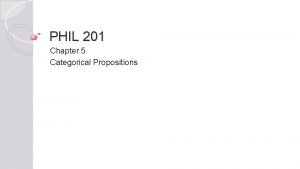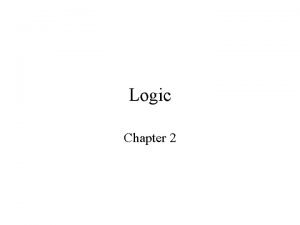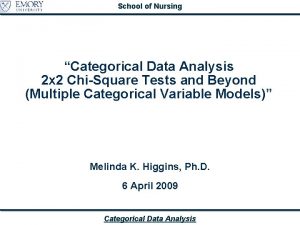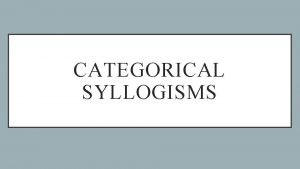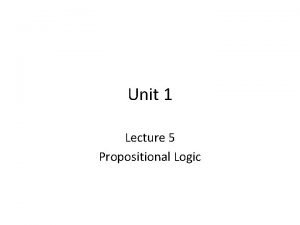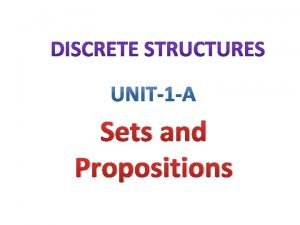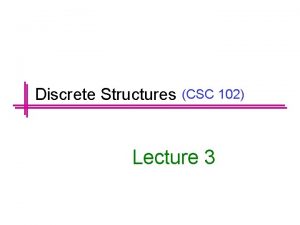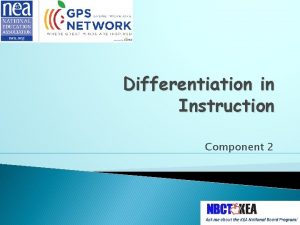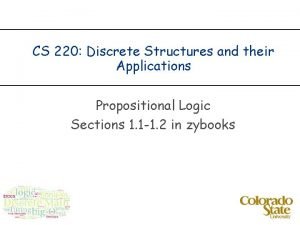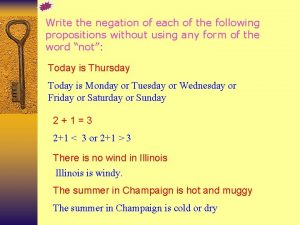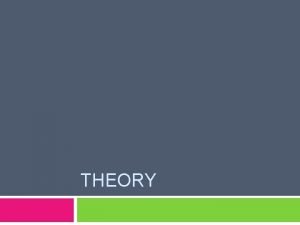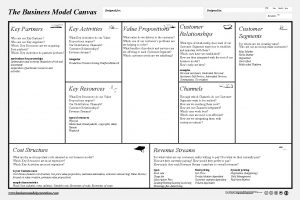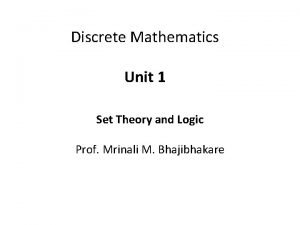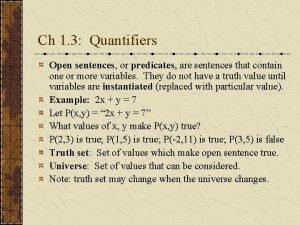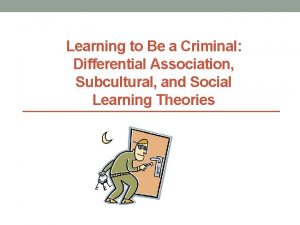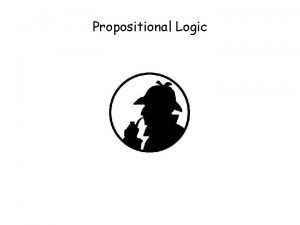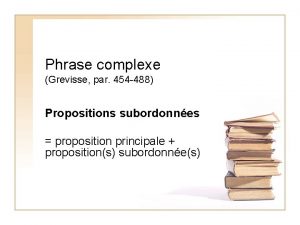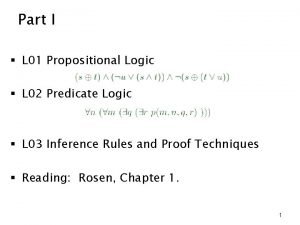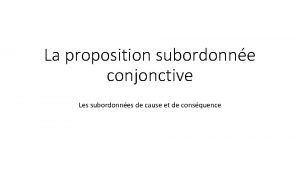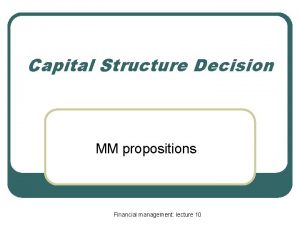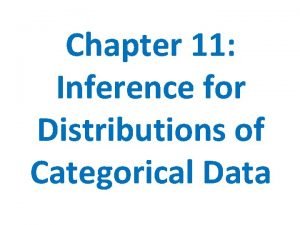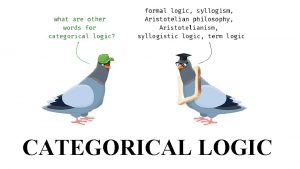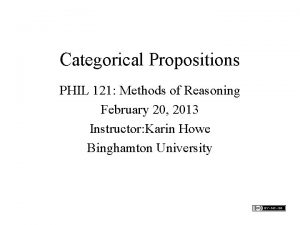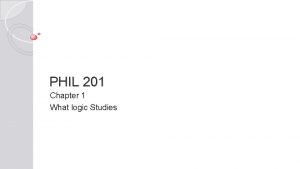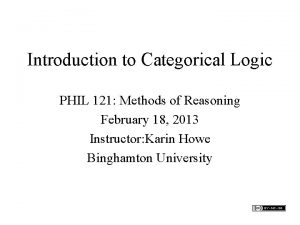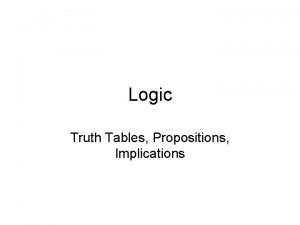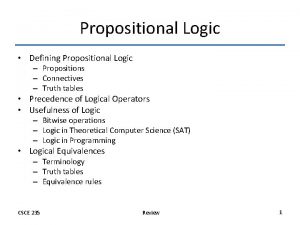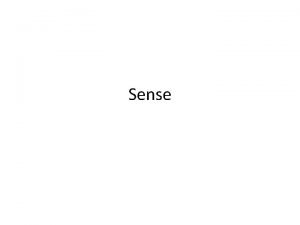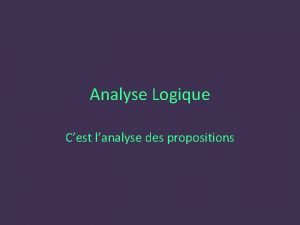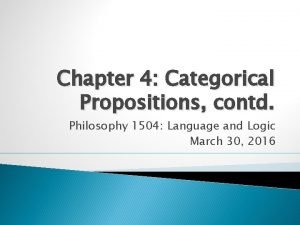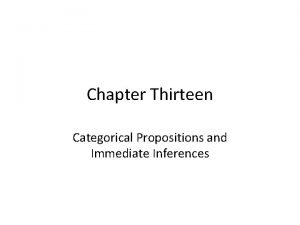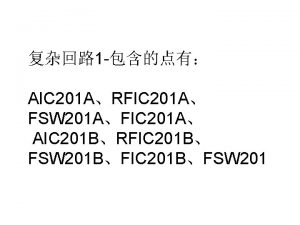PHIL 201 Chapter 5 Categorical Propositions Categorical Logic




































- Slides: 36

PHIL 201 Chapter 5 Categorical Propositions

Categorical Logic � Up to this point we have been relying on a seat of our pants analysis of arguments. This sort of thing is often very useful, but it fails in tough cases (like when people disagree about the validity of an argument). � What we need is a certain and objective method of evaluation. ◦ Any such system should be able to: 1)clarify our language; 2)reveal its logical structure; 3)define the concepts of logic; 4)evaluate arguments. � Categorical logic is one such system. It originated over 2000 years ago in the work of a Greek philosopher named Aristotle. � Categorical logic focuses on one particular form of deductive argument— categorical syllogisms. CSs are arguments whose constituent elements are categorical propositions.

The Components of Categorical Propositions �A categorical proposition is a proposition (statement) that relates two categories. ◦ A category is a class or group of things. ◦ It is important to recognize that categories aren’t necessarily objective features of our experience, but just ways of carving up the world. When our goals change, our categories often change with them. �All CPs have a subject class/term (what you are relating) and a predicate class/term (what you are relating the subject class to). ◦ The proposition asserts that all or some of the subject class are included in or excluded from the predicate class.

Standard Form CPs �Given that we can say something about all or some of the subject class, and that it can be included or excluded in the predicate class, we have 4 different ways in which categories can be related in CPs. �These 4 ways are called the Standard Form categorical propositions. To create them we need four elements: 1. 2. 3. 4. Quantifiers: “All, ” “No, ” or “Some” Subject Term: Noun or Noun Phrase Copula: “are” or “are not” Predicate Term: Noun or Noun Phrase

The Four Categorical Forms �All CPs are resolvable into one of four forms, symbolized by the corresponding capital letter: CP Symbol Quantity Quality All S are P. (A) Universal Affirmative No S are P (E) Universal Negative Some S are P. (I) Particular Affirmative Some S are not P. (O) Particular Negative

Exercise 5 A �Example ◦ Some political documentaries are shows deserving of acclaim. �Answer ◦ Subject: political documentaries ◦ Predicate: shows deserving of acclaim ◦ This is an example of an I-proposition.

Quality, Quantity and Distribution �As the table on the last slide reveals, all categorical propositions can be characterized by both their Quality and their Quantity. �Quality characterizes whether the categorical form of the proposition is inclusive (Affirmative) or exclusive (Negative). ◦ A and I form propositions are affirmative, E and O form propositions are negative. �Quantity characterizes whether it is all (Universal) or part (Particular) of the subject class that is affirmatively or negatively related to the predicate class. ◦ A and E form statements are universal, I and O form propositions are particular.

Distribution �Our analysis of the standard form CPs reveals more than just the quantity and quality of the propositions, it also reveals something about the categories related in the propositions. �Distribution refers to whether a proposition says something about the whole class or category or not. ◦ A term is said to be distributed if the proposition makes an assertion about every member of the category named by the term; otherwise, it is undistributed.

Review of Distribution � A-propositions: All cats are mammals. ◦ Subject “cats” is distributed; the proposition asserts that every cat is a mammal. ◦ Predicate “mammals” is undistributed; the proposition does not make an assertion about every mammal. � E-propositions: No turtles are mammals. ◦ Both subject and predicate are distributed; the proposition asserts that not even one turtle is a mammal and not even one mammal is a turtle. � I-propositions: Some students are sophomores. ◦ Both subject and predicate are undistributed; the proposition does not make an assertion about every student or every sophomore. � O-propositions: Some cars are not fuel-efficient vehicles. ◦ Subject “cars” is undistributed; the proposition does not make an assertion about every car. ◦ Predicate is distributed, since at least one member of “cars” is excluded from every member of “fuel-efficient vehicles. ”

Quantity, Quality, and Distribution

Exercise 5 B Example I: State quality, quantity, and distribution: Some protein supplements are not healthy diet aids. Answer: Particular negative; subject undistributed; predicate term distributed Example II: Change quality but not quantity: Some protein supplements are not healthy diet aids. Answer: Some protein supplements are healthy diet aids.

Exercise 5 B Example III: Change quantity but not quality: Some protein supplements are not healthy diet aids. Answer: No protein supplements are healthy diet aids. Example IV: Change both quantity and quality: Some protein supplements are not healthy diet aids. Answer: All protein supplements are healthy diet aids.

Existential Import � The logical machinery we are developing will provide a formal, objective means of determining an argument’s validity, with one important concern. � It turns out that the formal analysis of the connections between sets of standard form CPs is importantly constrained by a semantic ambiguity in universal form statements. � Compare: ◦ All horses are mammals. (True since horses exist? ) ◦ All unicorns are mammals. (False since unicorns do not exist? ) � Universal propositions that assert inclusion or exclusion about an actually existing subject term have what is called “existential import, ” that is, it says something about something that actually exists. If the subject term doesn’t exist, that the universal proposition doesn’t have existential import. � Aristotle developed a categorical logic that handled the difference between CPs with EI and CPs without; a more contemporary point of view (Boolean) denies that any universal form propositions have existential import. ◦ Reflecting the difference, logicians say that Aristotle’s system is open to existence and that the modern/Boolean form is closed to existence.

Venn Diagrams �We are going to start with the modern/Boolean interpretation, because it’s simpler and we can see the basic logical relations very easily. �A tool that logicians use to represent the meaning of standard form CPs is called a Venn Diagrams. ◦ A VD is a graphical way or representing the relationship that exists between the categories named in the proposition. ◦ Circles are used to represent the categories, and they are drawn overlapping so that we can capture the relationship articulated in the proposition. ◦ The VD for a CP is composed of two overlapping circles (for the two classes named in the proposition). ◦ Each standard form CP has a characteristic VD.

Venn Diagrams for Categorical Propositions (Boolean Interpretation)

The Modern Square of Opposition � The VDs for the standard form CPs help us see how the CPs are related to each other. ◦ Compare the VDs for the A and the O form propositions. Notice that they assert contradictory relations. The A says that all of the subject class is in the predicate class; whereas the O says that there is at least one member of the subject class that is not in the predicate class. ◦ What this shows us is that there is an explicit logical relationship between the A and the O form statements. If the A form statement is true, then the O form statement has got to be false. � The same relationship exists between the E and the I form statements. ◦ This relationship is called the Contradictory relation, and it is represented in the diagrammatic expression of the logical relations operative in the Boolean context: the Modern Square of Opposition.

The Modern Square � Because it is closed to existence, the only logical relation that the modern interpretation permits is the contradictory relation. ◦ It allows us to infer that if an A statement is true, the corresponding O is false, and vice versa. ◦ The same is obviously the case for Es and Is. � All other possible relations between categorical propositions have no truth implications, and thus no logical determinacy.

Putting It To Work � We can use the contradictory relation highlighted by the modern square to specify the truth values of related propositions and to test what are called “immediate inferences. ” � If the truth value of a particular CP is specified, the square can be used to make determinations about the truth value of related propositions. � These are very simple arguments, one premise and a conclusion. If the inference relies on one of the contradictory relations and we know the truth value of the premise, we can specify the truth value of the conclusion and thus determine if the truth of the premise guarantees the truth of the conclusion (determine if it’s a valid inference).

Exercises 5 D Example Some violinists are not musicians with perfect pitch. Answer Let V = violinists, and P = musicians with perfect pitch.

The Operations � The system of logical evaluation made possible by the Boolean interpretation seems pretty limited. Only the contradictory relationship allows for any evaluation. � We can extend the system quite a bit to cover inferences to and from statements that don’t at first glance seem to be contradictories by noting relations of logical equivalence between standard and non-standard form propositions. ◦ These are relations of logical synonymy. The propositions in question will always have the same truth value, so they can be plugged in for each other in an argument without changing the logical analysis of the argument. � There are three operations that can be used (in certain instances) to create such logical equivalencies. Here’s the first. ◦ Conversion �Operation: Switch the subject and predicate terms of the proposition. �Range: produces logically equivalent propositions of E and I form statements.

Conversion �In addition to representing standard form CPs, Venn diagrams can be used to illustrate the validity and invalidity of immediate inferences. �Here is the modern interpretation illustrating conversion.

Obversion and Contraposition � Here are the other two: obversion and contraposition. � Obversion ◦ Operation: This is a two step operation. Step 1 is to change the quality of the proposition (affirmative to negative, or vice versa). Step 2 is to replace the predicate term with its Term Complement (usually formed by appending non-to the term). ◦ Range: Obversion creates logically equivalent statements with all standard form CPs. � Contraposition ◦ Operation: Another two step operation. Step 1 is to switch the subject and predicate terms. Step 2 is to replace each term with its term complement. ◦ Range: Contraposition creates logically equivalent statements with A form and O form statements.

Obversion �Here’s the modern interpretation of Obversion.

Contraposition �And here is the modern interpretation of Contraposition.

Summary of Conversion, Obversion, and Contraposition

Exercise 5 E Example Some martial arts teachers are not tournament winners. Answer Converse: Some tournament winners are not martial arts teachers. Obverse: Some martial arts teachers are non-tournament winners. Contrapositive: Some non-tournament winners are not non-martial arts teachers. (Conversion does not produce a logical synonym for O-propositions. )

The Traditional (Aristotelian) Square of Opposition � The openness to existence of the Aristotelian standpoint produces a much richer field of logical evaluation. � The traditional square reveals this richness. ◦ Contradictories: A-O and E-I (same as modern square) ◦ Contraries: A-E (can’t both be true, can both be false). ◦ Subcontraries: I-O (can both be true, can’t both be false) ◦ Subalternation: � Truth “Flows Down” from A-I and EO � Falsity “Flows Up” from I-A and O-E

Immediate Inferences and Fallacies with the Traditional Square � Like we did with the modern or Boolean square, we can use the Traditional Square of opposition to test immediate inferences. ◦ Now, however, the range of inferences that we can successfully evaluate is much broader, because it includes all of the possible inferences captured in the contrary, subcontrary and subalternate relations. � There is also a broader range of formal fallacies that reference this expanded range of relationships: illicit contrary, illicit subcontrary, and illicit subalternation. ◦ There is also a version of the existential fallacy specific to the Aristotelian interpretation. In instances when this fallacy is possibility, we can establish conditional validity and then determine if the class named by the subject term of the universal proposition has any actual members.

Venn Diagrams and the Traditional Standpoint � The Aristotelian standpoint requires that we add a new symbol to our Venn diagrams. ◦ A circled ‘x’ represents the existential assumption that is made by the Aristotelian standpoint. � We can use our modified Venn diagrams to test the traditional square of opposition and as another way of testing immediate inferences.

Immediate Inferences in the Traditional Square �We can use the traditional square, just like we used the modern one, to test the validity of immediate inferences. ◦ Premise: All clowns are scary people. ◦ Conclusion: Some clowns are scary people. �This argument is valid in the traditional perspective, because a true A specifies the truth of the corresponding I by the subalternate relationship. �It is invalid from the modern perspective. �Compare: ◦ All clowns are scary people. Therefore, no clowns are scary people. �In this case, the contrary relationship says that corresponding As and Es cannot both be true, so if the A is true, the E has to be false. But the conclusion says the E is true, so this is an invalid argument. �It obviously invalid from the modern perspective as well.

Exercises 5 F Example All world travelers are cosmopolitan persons. Therefore, some world travelers are cosmopolitan persons. �Answer (comparison) Modern interpretation INVALID: The I-proposition requires an “X” in the area between S and P. Traditional interpretation PROVISIONALLY VALID: The Iproposition follows based on the assumption of existence.

Conversion, Obversion, Contraposition in the Traditional Square �Conversion: has “Conversion by limitation” �Obversion: same as in Modern Square �Contraposition: has ‘Contraposition by limitation’

Conversion in the Traditional Square �Conversion valid (E, I): Interchange subject and predicate terms �Conversion by limitation valid (A): Change A- proposition into its corresponding I-proposition, then convert ◦ Convertend A: All carrots are vegetables. ◦ Corresponding particular I: Some carrots are vegetables. ◦ Converse I: Some vegetables are carrots. �Conversion not valid (O) ◦ Convertend O: Some vegetables are not carrots. ◦ Converse O: Some carrots are not vegetables. (not a valid immediate inference)

Contraposition in the Traditional Square � Contraposition valid (A, O): Exchange subject with predicate; then replace each with term complements � A: All S are P. � Contrapositive A: All non-P are non-S. � Contraposition by limitation valid (E): Change an E-proposition into its corresponding O-proposition; then apply contraposition � E: No gorillas are lions. � Corresponding particular O: Some gorillas are not lions. � Contrapositive I: Some non-lions are not non-gorillas. � Contraposition not valid (I) � I: Some humans are non-registered voters. � Contrapositive I: Some registered voters are non-humans.

Exercises 5 G �Example I � The subcontrary of “Some columnists are coffee drinkers” is � (a) All columnists are coffee drinkers. � (b) No columnists are coffee drinkers. � (c) Some columnists are not coffee drinkers. �Answer ◦ (c) is correct. Since “Some columnists are coffee drinkers” is an Iproposition, its subcontrary must be an O-proposition. ◦ (a) is an A-proposition, the superaltern of an I-proposition. ◦ (b) is an E-proposition, the contradictory of an I-proposition.

Exercises 5 G �Example II ◦ If it is true that “Some physicians are not good communicators, ” then the proposition “No physicians are good communicators” is �True �False �Undetermined �Answer ◦ c. Undetermined. The first is an O-proposition, and if true, its superaltern, the E-proposition, could be true or false.
 Components of categorical proposition
Components of categorical proposition Associative law
Associative law Genderx nurse
Genderx nurse Categorical syllogism deductive or inductive
Categorical syllogism deductive or inductive First order logic vs propositional logic
First order logic vs propositional logic First order logic vs propositional logic
First order logic vs propositional logic First order logic vs propositional logic
First order logic vs propositional logic Concurrent vs sequential
Concurrent vs sequential Tw
Tw Software development plan
Software development plan Majority circuit
Majority circuit Combinational logic sequential logic 차이
Combinational logic sequential logic 차이 If x = 0 and y = 1, which output line is enabled?
If x = 0 and y = 1, which output line is enabled? Propositional logic
Propositional logic Sets and propositions
Sets and propositions 19 propositions rogers
19 propositions rogers Fuzzy proposition
Fuzzy proposition Conditional proposition example
Conditional proposition example 5 core propositions
5 core propositions True proposition examples
True proposition examples Behavioral segmentation divides consumers according to
Behavioral segmentation divides consumers according to Phrase conditionnelle irréelle
Phrase conditionnelle irréelle What is the negation of each of these propositions
What is the negation of each of these propositions Examples of reciprocal determinism
Examples of reciprocal determinism Business model canvas examples
Business model canvas examples Set theory and logic discrete mathematics
Set theory and logic discrete mathematics Open propositions and quantifiers
Open propositions and quantifiers Criticism of differential association theory
Criticism of differential association theory Propositions and arguments
Propositions and arguments Algebra of propositions
Algebra of propositions Proposition infinitive
Proposition infinitive Algebra of propositions
Algebra of propositions Les propositions
Les propositions Single minded proposition example
Single minded proposition example M&m propositions
M&m propositions Partner business propositions
Partner business propositions Biologists wish to cross pairs of tobacco plants
Biologists wish to cross pairs of tobacco plants
